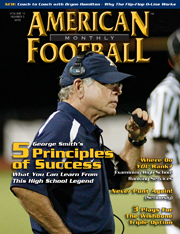Article CategoriesAFM Magazine
|
3 Complementary Plays To The Wishbone Triple Optionby: Paul Anthony MarkowskiFullbacks Coach Simon Fraser University (CAN) © More from this issue The wishbone triple option play is the base play within the greater wishbone triple option offensive philosophy. As its name indicates, it is actually three plays in one. There is a dive option to the fullback, a quarterback keep off-tackle option, and a halfback option pitch play to the perimeter of the field. Triple option teams almost exclusively use this option play over and over again and, in most cases, it has become a very productive offensive force. However, at some point during a game, it does become necessary to “change it up” in order to keep the defense guessing. It is at this point in a game when the triple option complementary plays should be put into the game plan. Here are three triple option complementary plays that can be used at any time during a game. Base Play:
Wishbone Option, Triple Right ....The full article can only be seen by subscribers.
|
|
|||||||
| HOME |
MAGAZINE |
SUBSCRIBE | ONLINE COLUMNISTS | COACHING VIDEOS |
Copyright 2025, AmericanFootballMonthly.com
All Rights Reserved





